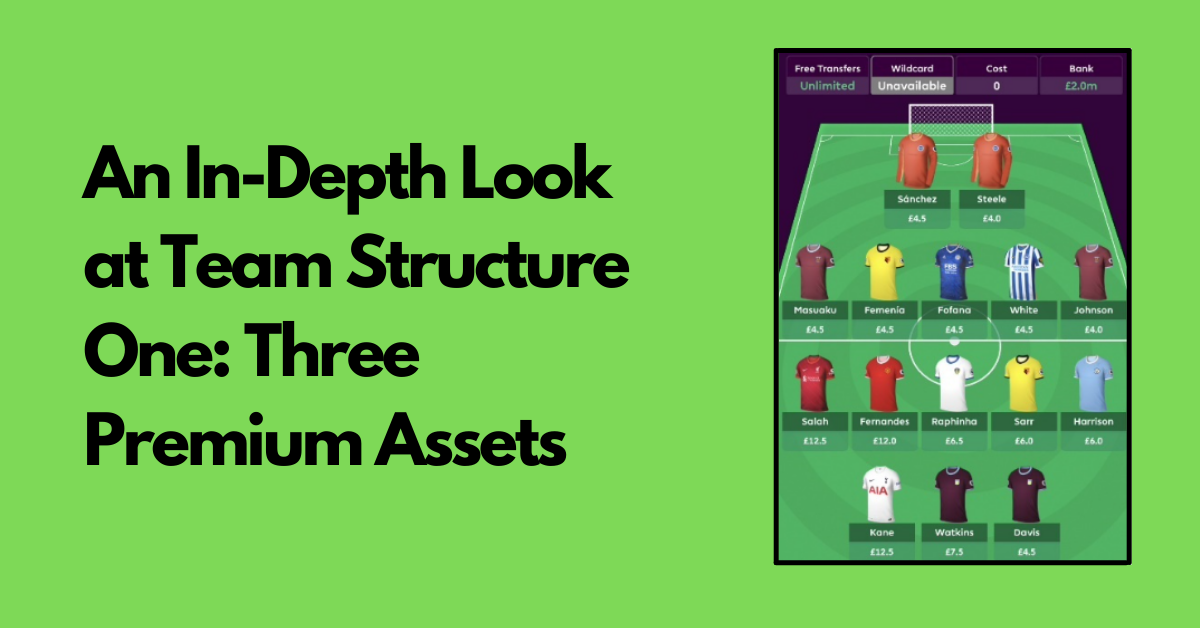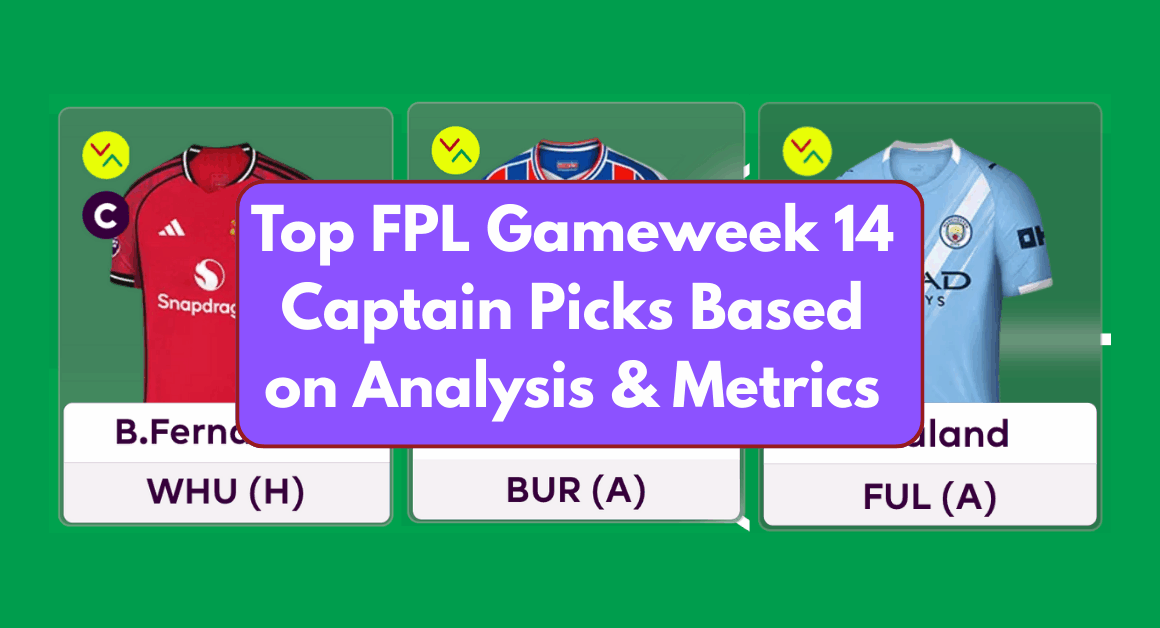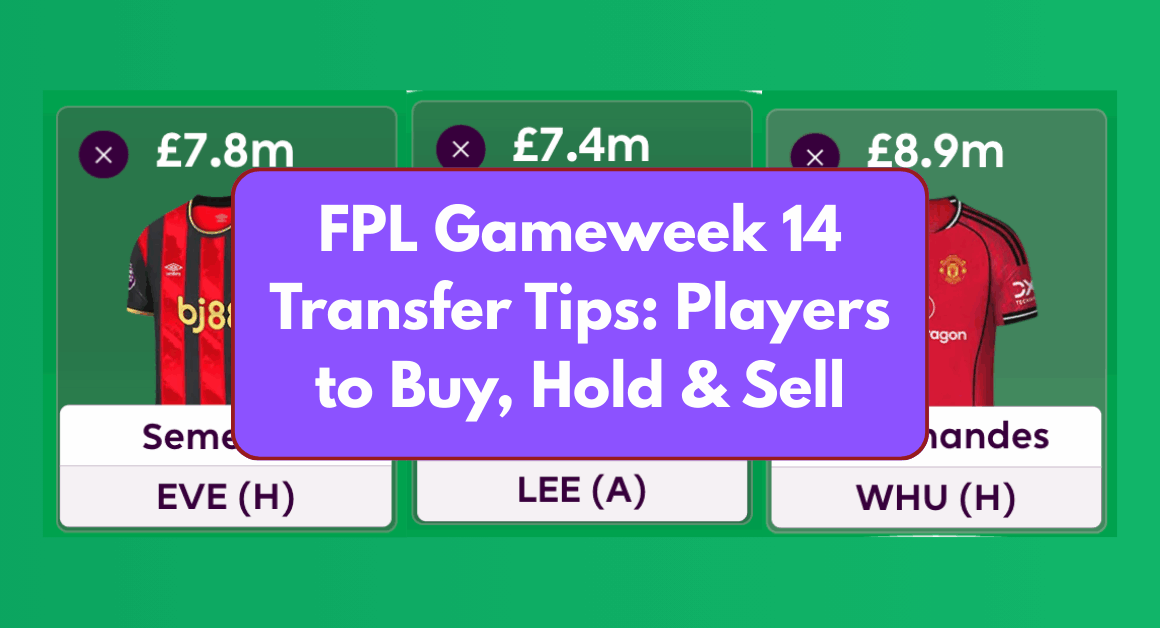Following my guide to FPL Team Structure approaching the 21/22 season, I am expanding that analysis by diving deeper into each of the team structures. The guide provides a brief analysis of each structure, but there is much to expand on. With this series of articles, I will go one by one and look at each of the four-team structures identified in the guide. Each structure will be broken down into several sub-structures – various recommended options to further define the overall structure. Do not understand these as prescriptive recommendations, but as specific examples meant to be learned from. These articles are not about telling you which assets to pick, but rather exploring various options that can help you structure your own thought process. In the first installment of this four-part series, I will be analyzing FPL Team Structure 1: Three Premium Assets.
*Disclaimer: This article was written before Sancho’s price release. I have included him under the assumption that his price is 10-10.5 m, and in that case, he can be directly substituted for Son. As well, the team images were taken before the game changed Harrison’s kit.
In case you missed out on the first blog in this series, FPL Team Structure approaching the 21/22 season. Do give it a read!
Introduction to FPL Team Structure
The premise of this FPL team structure is simple: fit as many premium assets into a team as possible. Premium assets are priced so high because they are assets who play for a dominant club and have a pedigree as a top-scoring asset; they are consistently the best assets in the game. It is technically possible to fit four premium assets in and still, have a full starting XI, but the sacrifices made to do so will almost never result in a successful team. Three premium assets, on the other hand, is a viable option for a successful FPL team, although there are sacrifices made in the process.
Last season, there were five players who scored over 200 points: Bruno (244), Kane (242), Salah (231), and Son (228). These four were by far the highest-scoring assets and their prices this season reflect that: Bruno (12.0 m), Kane (12.5 m), Salah (12.5 m), and Son (10.0 m). I am labeling any player 10.0 million or above as a premium player, although there is a big difference between a 10.0 m asset and a 12.5 m asset. Aside from the four 200+ point players, there are five other premium assets: KDB (12.0 m), Mane (12.0 m), Sterling (11.0 m), Vardy (10.5 m), and Aubameyang (10.0 m). Out of these nine assets, there are 84 possible ways to pick three. The point of this article is not to exhaust all those possibilities, but to look at a few of the more favorable ones. I will refer +.3 to each specific combination of premiums as a “sub-structure” and I will assess four sub- structures in this article:
- Kane (12.5 m) + Salah (12.5 m) + 12.0 m midfielder
- Kane (12.5 m) + Salah (12.5 m) + Son (10.0 m)
- Salah (12.5 m) + 12.0 m midfielder + 12.0 m midfielder
- Salah (12.5 m) + 12.0 m midfielder + Son (10.0 m)
These four sub-structures should offer a wide enough perspective to accommodate any of the premium asset combinations, should you as a manager prefer something different. Salah is included in every sub-structure, but if you do not fancy him as an asset (you maniac), switching him with a 10.0- 12.0 midfielder will only offer you more funds elsewhere. The same concept goes for Kane, who can be substituted for Vardy or Aubameyang. Sub-structures 1-2 and 3-4 are very similar, however, I want to analyze the implications of saving 2.0 million by utilizing Son.
FPL Sub-Structure 1: Kane + Salah + 12.0 m Midfielder
The first sub-structure is one that I previewed in the guide. It also happens to be the priciest of the four sub-structures, with the three premiums totaling 37.0 million. If Kane moves to City, I would expect this structure to become very popular among managers. This sub-structure allows you to fit in the three highest-scoring assets of the 20/21 season if you go with Bruno for the final premium, but it also allows you to pick between him, KDB, and Mane for that third spot. So, what are the benefits of this sub-structure? And given that so much money is spent on premium assets, what effect does this decision have on the rest of the team?
The Upside
The first noteworthy benefit of this sub-structure is that it allows great fluidity between premium assets. You are only one transfer away from turning any of the three premiums into any other player in that position, given that these are the highest-priced assets. The ability to only use one transfer to shift from premium to premium is a luxury as a manager. Whether that change comes about because of injury, drop/rise in form, or targeting fixtures, this fluidity is very valuable.
Second, this sub-structure provides a plethora of captaincy options. Granted, you must be able to pick the right captains to benefit from this factor, but the opportunity is there. At a quick glance, captain rotation could work as follows for the first eight weeks: Salah (nor), KDB (NOR)/Bruno (sou), Kane (WAT), Kane (CRY)/Bruno (NEW), Salah (CRY)/KDB (SOU), Salah (bre), Kane (AVL), Salah (wat)/Kane (new). This captaincy rotation looks appetizing and avoids some tough fixtures that a two-premium structure runs into.
The Downside – Budgeting the Rest of the Squad
Given that so much money is being spent on the three premium assets, the downside to this structure is the restrictions it forces for the rest of the team. With the three most expensive premiums totaling 37.0 million, that leaves 63.0 million to spend on 12 players. Let us say that three of those players are bench fodder: a 4.0 m keeper, 4.0 m defender, and a 4.5 m midfielder/forward.
This leaves 50.5 million for nine players that you want to be able to start every game week, an average of 5.61 m per remaining player. I will go position by position to assess the options viable for this sub-structure. I will fill in the cheapest options first, looking at possible upgrades once the bare bones of the squad are put together.
Goalkeeper – Along with the 4.0 bench keeper, you will want to minimize funds by selecting a 4.5 starting keeper. The reasonable options at this price are Sanchez (Brighton, popular favorite), Bachmann (Watford), Raya (Brentford), Krul (Norwich), Guaita (Palace), and McCarthy/Forster (Southampton). Sanchez is the obvious pick given Brighton’s sensational xGA numbers (3rd in 20/21 at 37.7 xGA) but another option may emerge within the early weeks, similar to Emi Martinez’s emergence in 20/21. I would go for Sanchez at the start (for safety), but you could punt on another option. Remaining budget: 46.0 million.
Defenders – Along with the 4.0 bench defender you will want four playing defenders, looking to rotate with a three-back formation. The cheapest method of doing this is selecting four 4.5 million defenders. If there is budget left over after filling out the cheapest squad, we will look at upgrading one or two of these assets. The 4.5 m defender range has been touted as a value for money group, since the prices were originally revealed.
Noteworthy 4.5 m assets include: Ayling (Leeds), Coady (Wolves), Femenia/Rose (Watford), Holding (Arsenal), Lamptey/Veltman/White (Brighton), Lowton (Burnley), and Masuaku (West Ham). There are plenty of options at this price point, but you cannot expect any to perform as well as the 5.0+ options. Although there will be an asset at this price that reveals their value at some point (such as Dallas or Justin in 20/21), it will take time to identify that asset. Remaining budget: 28.0 million.
Midfielders – The midfield has three spots remaining, to be filled with assets at the 5.5-6.5 million range. This is the lowest price point at which you can reasonably expect a consistently valuable asset. There is the decision to be made about picking the 4.5 m bench player as a midfielder or a forward, but I see more value in the cheap midfielders therefore I will build the team with a 4.5 m forward.
At the 5.5-6.5 million price bracket, noteworthy assets include: Bowen/Fornals/Soucek (West Ham), Buendia (Villa), Raphinha/Harrison (Leeds, assuming Harrison moves back), Saka/Smith Rowe (Arsenal), Ward-Prowse (Southampton), and Sarr (Watford). Like the 4.5 m defenders there are plenty of options, they just might not reveal their value right away. Raphinha and Harrison are the stand-out options to me, although everyone listed above looks to be good value. I would put Raphinha in the team alongside two 6.0 m assets. Remaining budget: 9.5 million.
Forwards – Alongside Kane and a 4.5 m bench asset, there is one spot to fill and 9.5 million to do so. I would not recommend spending all these funds on that one slot, as the team selected so far is as cheap as can be. Reasonably, I would look at the 7.5 m options because there are several consistent assets: Antonio (West Ham), Iheanacho (Leicester), Richarlison (Everton), and Watkins (Villa). Remaining budget: 2.0 million.
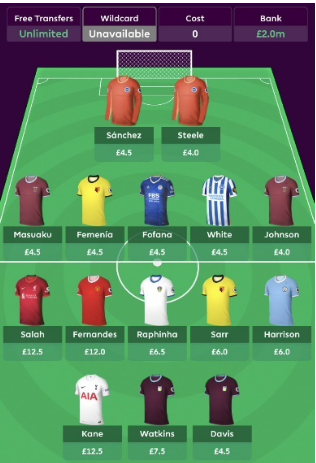
Upgrades – After filling out the bare bones of this sub-structure, there is 2.0 million to upgrade where you see fit. The first place I would look to is the defense, as four 4.5 m assets appears very weak. Using all the funds there would fit in two 5.5 m assets: Cresswell (West Ham), Digne (Everton), and Shaw (ManU) being the stand-out options. Similarly, you could only upgrade only one 4.5 m defender to a 5.5 and have an extra million to upgrade a midfielder or the 7.5 million forward. If you are happy to have four 4.5 m assets in defense, possible upgrades include a 6.0 m midfielder to a 7.0-8.0 m midfielder and/or the 7.5 m forward to an 8.0-9.0 m forward.
Possible Squads with this FPL Team Structure
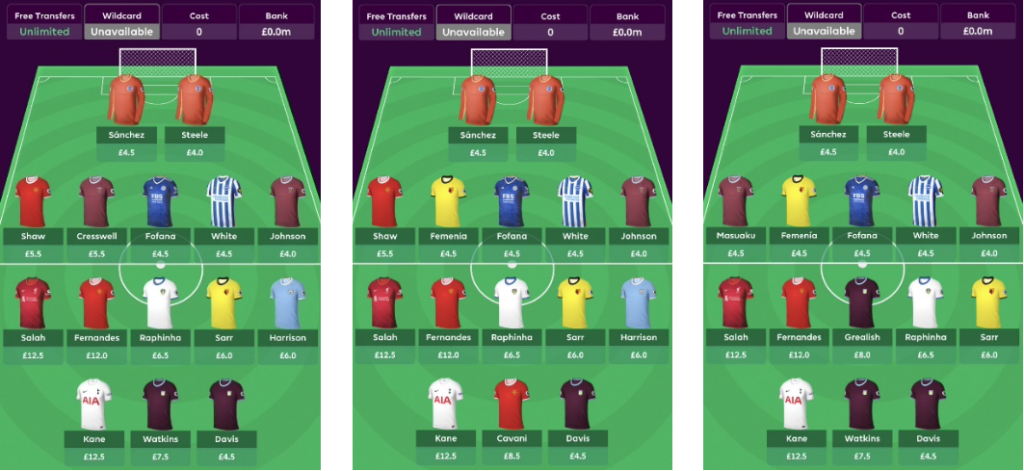
There is also one other iteration to note, that fits in three premiums AND Trent. This structure plays a 442 formation and is as follows:
- Goalkeepers: 4.5/4.0
- Defenders: Trent/5.5/(4.5 or 5.0)/4.5/4.5 Midfielders: Salah/Bruno/6.5/6.0/4.5
- Forwards: Kane/(6.5 or 6.0)/4.5
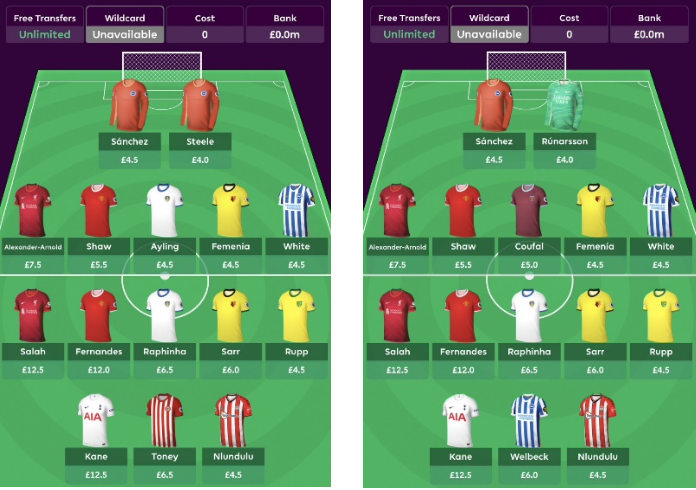
While I believe this is spreading the squad too thin with the rotation of 4.5 defenders and a starting 6.0/6.5 forward every gameweek, it is a viable option. Perhaps if a budget option emerges at each of those price points, this structure could work very well for early wildcarders.

FPL Sub-Structure 2: Kane + Salah + Son (or Sancho)
FPL Sub-structure 2 is perhaps better labeled as sub-structure 1.2, as it is a slight variation on the previous option. This option is for those who believe that Son (or perhaps Sancho once his price comes in) can perform as well as the 12.0 m premiums. Son’s 20/21 season and Sancho’s Bundesliga stats would suggest so, however, there are uncertainties for both assets. The main concerns for Son are if Kane stays at Spurs, how Nuno will influence Spurs’ play, and if he can stay injury-free.
For Sancho, the concern is how he will adapt to the Premier League and how his role at Man United will translate to the scoring of FPL. Assuming one of the two can perform at the level of Bruno, KDB, and Mane, this sub-structure (and the extra 2.0 m it saves) could be a great option.
The upsides and downsides are similar to the previous structure, the main caveat is that the extra 2.0 m saved comes with a bit of a (presumed) risk. So, is that extra 2.0 m worth the risk? Let us look at how those funds can support the rest of the squad. (In sub-structure 4 I look at a statistical comparison of Son vs. other premiums, so make sure to read that as well if you are interested in either of these options).
Upgrading FPL Sub-Structure 1
There are three primary ways to upgrade the previous structure with 2.0 m: spend that all on upgrading one asset, split the funds to upgrade two assets by 1.0 m, or split the funds evenly by slightly upgrading assets by 0.5 m. I will be using the first suggested upgrade structure from sub-structure 1, as that is my personal favorite of the three presented. I will try to provide a broad yet selective set of options for each upgrade.
Upgrading one asset – The first thing that jumps out is that the 2.0 m saved with Son allows for a 5.5 m defender to be upgraded to Trent. The main weakness of sub-structure 1 was its lack of premium defenders, which this upgrade fixes. If you prefer the 5.5 m options to Trent, you can look to the midfield or forwards for upgrades. In the midfield, the 8.0-8.5 m assets are now on the table.
You could swap the likes of Raphinha for Havertz or Sarr/Harrison for Grealish/Foden. In the forward line, there is not an option at 9.5 m, but you could swap out the 4.5 m bench forward for Toney at 6.5 m. Adding a 6.5 m forward not only fits in another popular asset but does so at the expense of no other starting asset, providing you with more options to pick each gameweek for your starting XI.
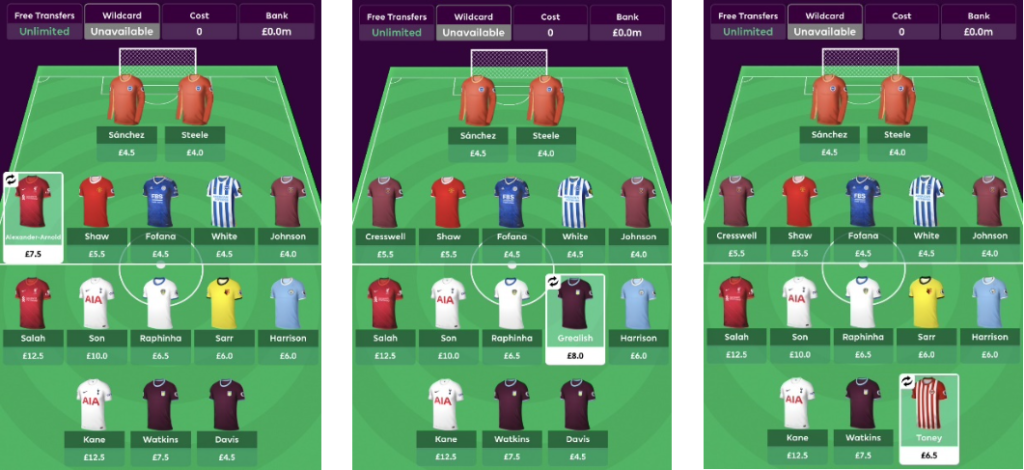
Upgrading two assets – For this, let us just go position by position and look at 1.0 m upgrades, with this option you can pick two of these upgrades to your liking. For goalkeeper, you could upgrade the 4.5 m asset to assets like Martinez or Pope. For the defenders, the only option to upgrade a 5.5 m asset would be to Van Dijk. Another option is upgrading one of the two remaining 4.5 m assets to add a third 5.5 m assets. This upgrade would allow for a team with three of: Cresswell, Digne, James, Maguire, Shaw, Stones, or Wan-Bissaka.
In the midfield, the possible upgrades entail switching a 6.0- 6.5 m asset to an 7.0-7.5 m asset. The favorable options at these prices include Greenwood, Gundo, Jota, and Mount at 7.5 m or Barnes, Ferran, or James at 7.0 m. For the forwards, a punt on a 5.5 m asset could provide another playing asset, otherwise, the option would be swapping the 7.5 m asset for Cavani, Jesus, or Lacazette. Looking at all these options, I see the most value in upgrading a 4.5 m defender or the 7.5 m forward.
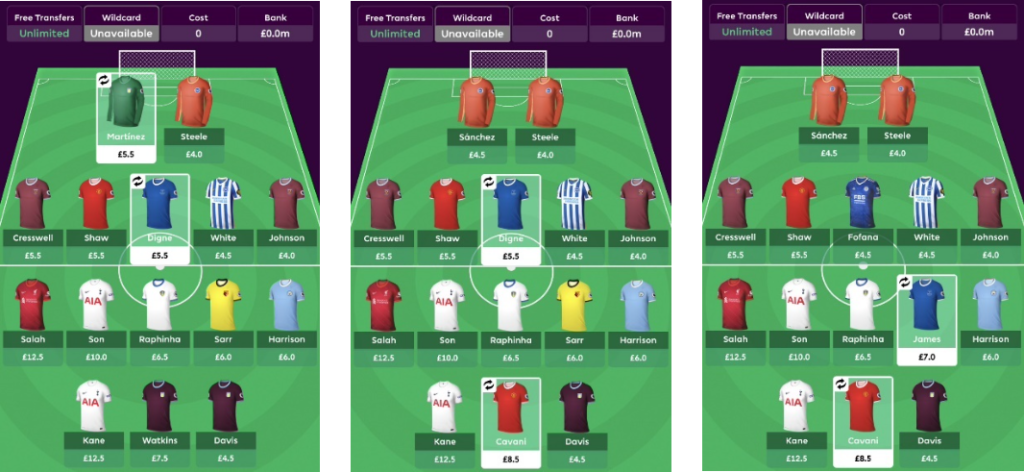
0.5 m upgrades – To spread the funds around, you could look at the cheapest upgrades for each position and see if there is a significant increase in value. The 4.5 m goalkeeper could be upgraded to a 5.0 m asset (Henderson, Meslier, or Schmeichel) or you could opt for a rotation between two 4.5 m assets (Sanchez/Bachmann rotation for example). In the midfield, the options would be upgrading the initial 6.5 m asset to a 7.0 m asset or upgrading an initial 6.0 m asset to add another 6.5 m asset (Bowen, Buendia, Raphinha, or Ward-Prowse). In the forward positions, the only option would be swapping the 7.5 m asset to one of the 8.0 m assets (Bamford, DCL, and Ings).
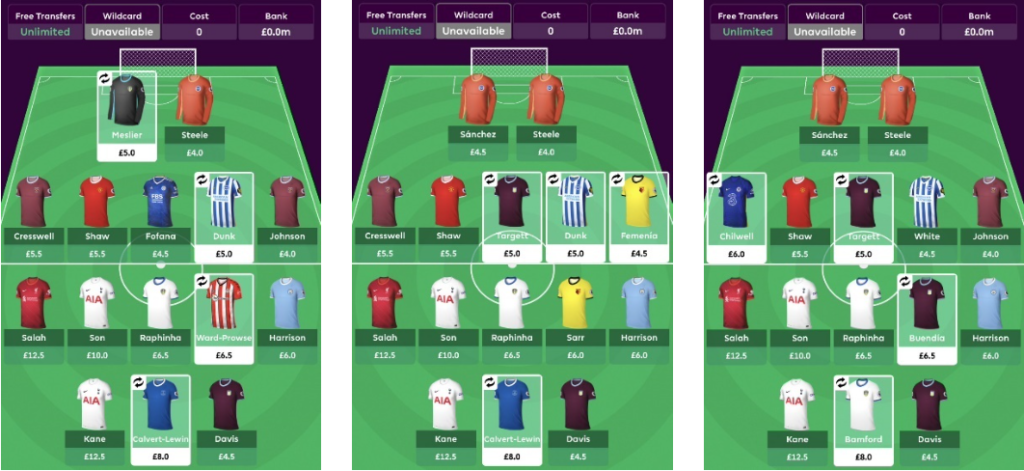

FPL Sub-Structure 3: Salah + 12.0 Midfielder + 12.0 Midfielder
Sub-structure 3 is similar to the first, although it favors a 12.0 midfielder to Kane. This is reasonable because not only do you gain an extra 0.5 million, but there are three 12.0 m midfield assets as opposed to Kane as the only 12.5 m forward. This offers greater flexibility because you can maintain structure while interchanging Bruno, KDB, and Mane dependent on form and fixtures. By switching out Kane for a 12.0 m midfielder, you also must switch out a 6.0-6.5 m midfielder for a 6.0-7.0 m forward. When deciding between sub-structure 1 and sub-structure 3, you must consider the value of rotating three mids versus sticking with Kane and the comparable combinations of [12.0-12.5 m] + [6.0-7.0 m] assets.
6.0-7.0 m Asset Comparison
A major part of the decision between Kane and a 12.0 m mid relies on which budget asset replaces the other. The midfielders are limited to 6.0-6.5 m while the forwards can stretch to 7.0 m, given the extra 0.5 m saved. The notable 6.0-7.0 m options at each position include:
- Midfielders – Bowen/Buendia/Raphinha/Saka/Ward-Prowse (6.5 m), Harrison/Sarr/Soucek (6.0 m)
- Forwards – Adams/Wood (7.0 m), Abraham/Rodrigo/Toney (6.5 m), Pukki/Welbeck (6.0 m)
- To directly compare combinations, two examples include: Kane/Harrison vs. KDB/ToneyKane/Sarr vs. Mane/Welbeck + 0.5 m
Although there are many possible combinations, you can apply this method of thinking to your preferred assets once you have established a base structure.
Possible FPL Squads with Salah + 12.0 Midfielder + 12.0 Midfielder
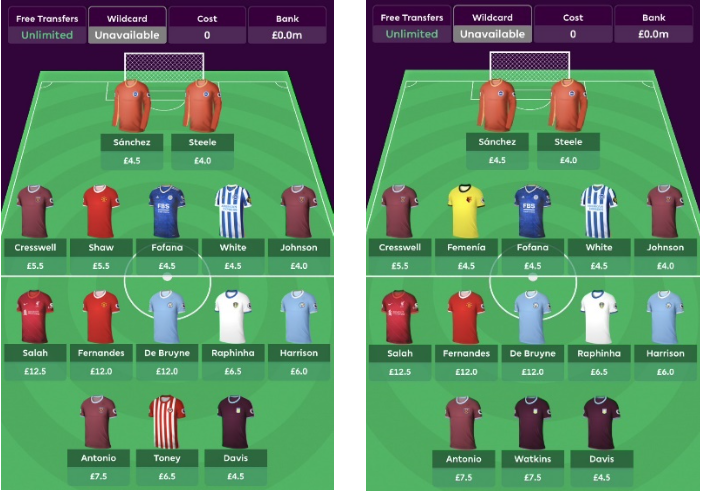
Conclusion: Pros and Cons
Out of the two options shown above, the first is the most enticing for me personally. In defense, you get two marquee defenders at the 5.5 m price point, which I believe to be good value and can help the damage of not owning Trent. The midfield is stacked and has flexibility within each of the price points, although you are locking yourself out of any midfielders between 7.5-11.0 m without sacrificing a premium. In the forward line, there is a choice of a 7.5 m forward alongside Toney at 6.5 m. This combination may not be ideal, but there is the possibility that it offers great value.
As noted with sub-structure 1, there is no lack of captaincy options. The three premium midfielders should offer a consistency that can support the rest of the team, it is more about finding the best combination of assets to support these three. As well, should one of these three premiums become injured, there is always the flexibility to downgrade them to the likes of Sterling, Son, Sancho, Rashford, or Havertz in one transfer. While I recommend sticking with a structure for the beginning of the season, this option will always allow you to shift from three premiums to two, whereas a two-premium structure can not be as easily shifted to a three-premium structure.
The downside to these options is the lack of high-priced defenders, mid-priced midfielders, and high-priced attackers. These are the three groups excluded, so if you see value in these price brackets this sub-structure may not be for you. If you believe that you can find the right mid-priced defenders, budget midfielders, and mid-priced forwards, then this is a great option for you. Every season, there are assets who outperform their initial pricing and offer the best value for money. Identifying these assets and structuring your team to support them is fundamental in doing well.

FPL Sub-Structure 4: Salah + 12.0 Midfielder +Son
Finally, we once again must question whether the final 12.0 midfield asset is worth the extra 2.0 m over Son (or Sancho). In sub-structure 2 I looked at ways to upgrade a squad from a cost perspective, but how much can Son truly cover other premium midfield assets? And can this deficit (or lack of) be balanced out by upgrades to other assets? Let us look at some key statistics in projecting Son’s value compared to other premium midfield assets.
Midfielder Scoring
Midfielders in FPL get 1 point for any game time and 2 points for >60 minutes of game time (like every asset). They get 5 points for a goal, 3 for an assist, and 1 for a clean sheet along with standard penalties for cards, own goals, and penalty misses. A great midfield asset gets consistent minutes, is one of the highest goal scorers in the league, contributes at least good number of assists, and is on a team with a high number of clean sheets. As well, penalty takers get more opportunities for goals and therefore, higher points generally. Out of the premium midfielders, the only assets with questionable minutes played are KDB and Sterling. Less so KDB if he is fit, but Man City are known for rotation. Some could argue that this lack of minutes is balanced by Man City’s attacking prowess.
Statistical Comparison – Goals
Key goal-scoring stats of the premium assets from the 20/21 season are as follows (taken from fbref.com):
Goals/90 minutes:
- Salah – 0.64
- Bruno – 0.52
- Son – 0.49
- Mane – 0.35
- Sterling – 0.35
- Sancho – 0.35
- KDB – 0.27
Expected Goals (xG)/90 minutes:
- Salah – 0.62
- Mane – 0.49
- Bruno – 0.45
- KDB – 0.44
- Sterling – 0.43
- Sancho – 0.32
- Son – 0.30
Salah’s statistics back up his price and history as a great FPL asset, there is a reason he has been included in every single squad I have made. Out of the three 12.0 m assets, their xG numbers are all around the same point, however Mane and KDB underperformed last season. If at least two of those three assets can perform to their xG this season, they will once again be value for money. Sterling is an interesting option as his xG is brilliant, but his rotation is the main concern. If a player does not get a high volume of minutes, their xG stats cannot translate to a great FPL asset. Lastly, Son performed opposite to KDB and Mane – he wildly overperformed his xG. Son is known as a historic overperformer of xG, but do his past statistics reflect that?
G/90 minus xG/90: 20/21 – +0.19 19/20 – +0.08 18/19 – +0.19 17/18 – +0.08
This is a strange pattern, and it would be quite something if Son finished with a +0.08 difference this season, but generally Son is an overperformer of xG. Although his xG statistics may seem low compared to the other premium assets, his clinical finishing ability should put him up there as one of the highest performers this upcoming season, once again.
Statistical Comparison – Assists
Key assist stats of the premium assets from the 20/21 season are as follows (taken from fbref.com):
Assists/90 minutes:
- KDB – 0.54
- Sancho – 0.48
- Bruno – 0.35
- Son – 0.29
- Sterling – 0.25
- Mane – 0.22
- Salah – 0.15
Expected Assists (xA)/90 minutes:
- KDB – 0.46
- Bruno – 0.32
- Sancho – 0.30
- Son – 0.26
- Mane – 0.18
- Salah – 0.18
- Sterling – 0.17
Although Son is near the top of the assist statistics, he is not as good as KDB or Bruno. The difference may not be so much as to justify an extra 2.0 m, but it cannot be overlooked that they offer more when it comes to assists. Son sits comfortably just below them though, offering a very high xA/90 and backing that up with his Assists/90 last season.
Defense and Penalties
Although it is a minimal part of the midfield scoring, those few points do matter in determining a premium asset’s worth. There are four clubs represented in the premium midfielders, whose Expected Goals Against/90 in 20/21 were as follows:
- Man City – 31.4
- ManU–42.2
- Liverpool – 45.3
- Spurs – 49.5
Notably, this was a Liverpool team without Virgil Van Dijk. With him back, Liverpool should be closer to Man City. Spurs’ defense lets Son down, as all the other premium assets are expected to get more points than him through clean sheet bonuses.
Lastly, Son is not on penalties for Spurs while Salah, Bruno, and KDB (assumedly) are on penalties for their clubs. This is the factor most detrimental to Son in his comparison to the 12.0 m assets. If Kane moves away from Spurs and Son becomes penalty taker, he could become even more valuable.
Other Factors
There are two main factors this summer surrounding Son: whether Kane leaves Spurs and how the appointment of Nuno as manager will affect Spurs’ tactics/performance. The first should be set in stone come the beginning of the season, but the latter will take some time to figure an answer for. Going for Son without Kane on Spurs is, in my opinion, a bad option.
Unless Son is on penalties, I do not think he can overcome losing his fellow marquee attacker. Their relationship has been a fundamental part of each other’s success that while Son will receive even more attention up front, I think he can more easily be targeted by other teams’ defenses. The significance of Nuno’s appointment will not reveal itself until we see Spurs play for at least a month, but I would not let that deter me from selecting Son.
Although Wolves’ attack was abysmal last season, Nuno has had successful attacks in past years. He is also not known as an overly defensive manager. Although he may use a five at-the- back system, Spurs will at least be able to generate chances on the counterattack. So long as Kane remains at City, I could see Son performing to the level of a 12.0 m premium asset once again, although there may be a slight regression in the number of goals he scores.
Possible Teams
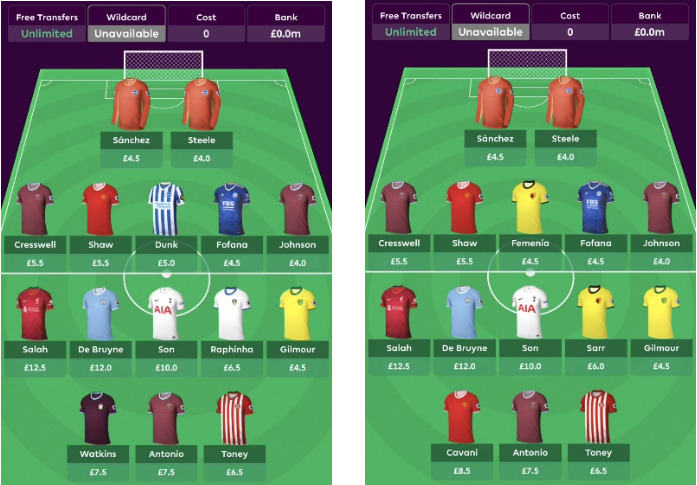

Don’t want to pay and try out a free trial instead?
Get a seven-day free trial for FFHUB now: Free trial
2021/22 FPL Season ALLABOUTFPL Mini League:
AllAboutFPL League (smfms7): Autojoin link
Thanks for reading the 2021/22 season FPL ream structure, three premiums blog. Keep checking allaboutfpl.com for regular blogs. Also, follow our 19000+community on Instagram, Facebook, and Twitter to stay updated on regular Posts and FPL updates. Link to all our 2021/22 FPL pre-season blogs. Check out our Rules and Basics Guide

Further Reads from ALLABOUTFPL Ahead of the 2021/22 Season:
2021/22 FPL Season: FPL Price Changes Explained | FPL Guide
2021/22 Fantasy Premier League Season Rules, Tips | The Ultimate Guide
What is Effective Ownership(EO) in FPL? | FPL Guide
A Guide to FPL Team Structure | 21/22 FPL Season (Pre Wildcard)
How Structure and Approach can Shape your 2021/22 FPL Season
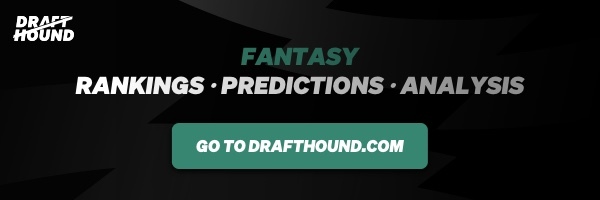
What’s next from ALLABOUTFPL ahead of the 2021/22 FPL Season?
We’ll be covering the lengths and breaths of FPL covering and analyzing every single topic possible right from team previews, fixture analysis, position analysis, tips, and strategy from our expert writers over the pre-season. Keep checking allaboutfpl.com for all our blogs and subscribe to our free newsletter through the link below. We’ll also be posting regularly about the same on our social media accounts so follow us on Twitter, Instagram, and Facebook keep our notification ON.
Our content is always free and if you like our content do drop a comment, follow, subscribe, and support us. Your love is what keeps us going:)

FPL GW1 FPL Deadline Countdown
Login and set your team for FPL GW1 now!
Alex Michel
Latest posts by Alex Michel (see all)
- FPL DGW37 Man City Preview | Player-Wise Analysis & Thoughts - May 18, 2023
- How to Approach Man City FPL Assets for FPL GW33-38 - April 24, 2023
- UCL Fantasy Tips & Players to Target- Matchday 7 - February 14, 2023

